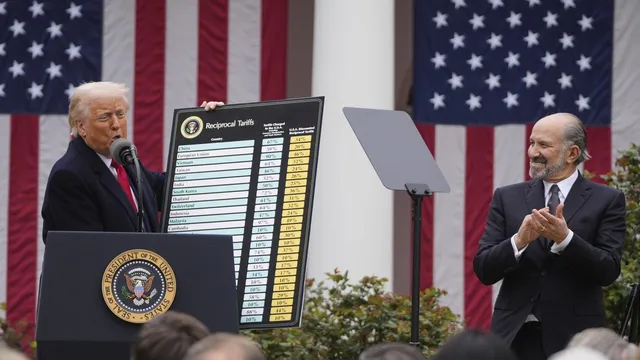
Trump imposes historic tariffs raising rates to 24%
2025-04-05 08:00- On April 3, 2025, President Donald Trump announced a substantial increase in America's tariff rate.
- The new tariffs will raise the effective tariff rate from about 2% to 24%, impacting global trade, particularly with Asia.
- This drastic change may lead to increased domestic prices and could provoke retaliatory actions from other countries.
Express your sentiment!
Insights
In a significant shift in trade policy, the United States has seen its effective tariff rate soar to 24%, the highest level in over a century. This notable change was announced by President Donald Trump on April 3, 2025, during a speech outside the White House, where he emphasized his administration's goal to 'Make America Wealthy Again.' The tariffs, intended to address trade imbalances and protect American industries, are particularly imposing on countries in Asia, which are expected to bear the brunt of these economic measures. Financial markets around the world reacted negatively to the announcement, with investors surprised by the depth and breadth of the new tariffs. The policy shift reflects a broader strategy by Trump to reshape the global economic landscape according to nationalist principles. This move has sparked concerns about rising prices domestically and potential retaliatory measures from affected countries. Analysts note that such a surge in tariffs may lead to higher costs for consumers and could hinder economic recovery efforts in light of already existing global economic challenges. As the United States embarks on this new trade path, the international community will be watching closely to see how this affects ongoing trade relations and global economic stability.
Contexts
The history of tariff rates in the United States has been marked by significant changes influenced by economic needs, political ideologies, and historical events. In the early years of the Republic, tariffs were primarily used to generate revenue for the federal government and to protect budding American industries from foreign competition. The Tariff of 1789 marked the first federal tariff law, designed to protect infant industries and raise necessary funds. Over the decades, the debate over tariffs would reflect larger economic shifts, especially between agrarian interests and industrial growth, creating a complex relationship between different American regions and their economic priorities. During the 19th century, tariffs became a contentious issue, particularly with the rise of the antebellum American economy. Notably, the Tariff of Abominations in 1828 created divisions between the agricultural South and the industrial North, leading to increased tensions that would later contribute to the Civil War. Following the war, the U.S. adopted higher tariff rates to support its recovering economy, culminating in the high tariffs of the late 19th century, such as the McKinley Tariff of 1890, which aimed to protect American manufacturers from foreign competition. As the 20th century progressed, attitudes toward tariffs shifted considerably, especially during the Great Depression. The Smoot-Hawley Tariff Act of 1930 raised duties to unprecedented levels in an attempt to protect American jobs, but it is widely regarded as exacerbating the economic downturn by stifling international trade. This backlash against high tariffs led to a wave of trade liberalization efforts throughout the mid-to-late 20th century, epitomized by the establishment of the General Agreement on Tariffs and Trade (GATT) in 1947, which sought to reduce tariffs and encourage global trade cooperation. In recent decades, the discussion around tariff rates has resurfaced, influenced by globalization and the rise of free trade agreements. The implementation of tariffs under different administrations has reflected a broader debate regarding the balance between protecting domestic industries and promoting free trade. Tariffs on specific goods, such as steel and aluminum in recent years, have sparked intense political and economic discussions regarding their effectiveness and impact on the U.S. economy. Overall, the history of tariff rates in the United States highlights the dynamic interplay between economic policy, political motivation, and international relations, illustrating the profound ways in which tariffs have shaped the nation's economic landscape over time.